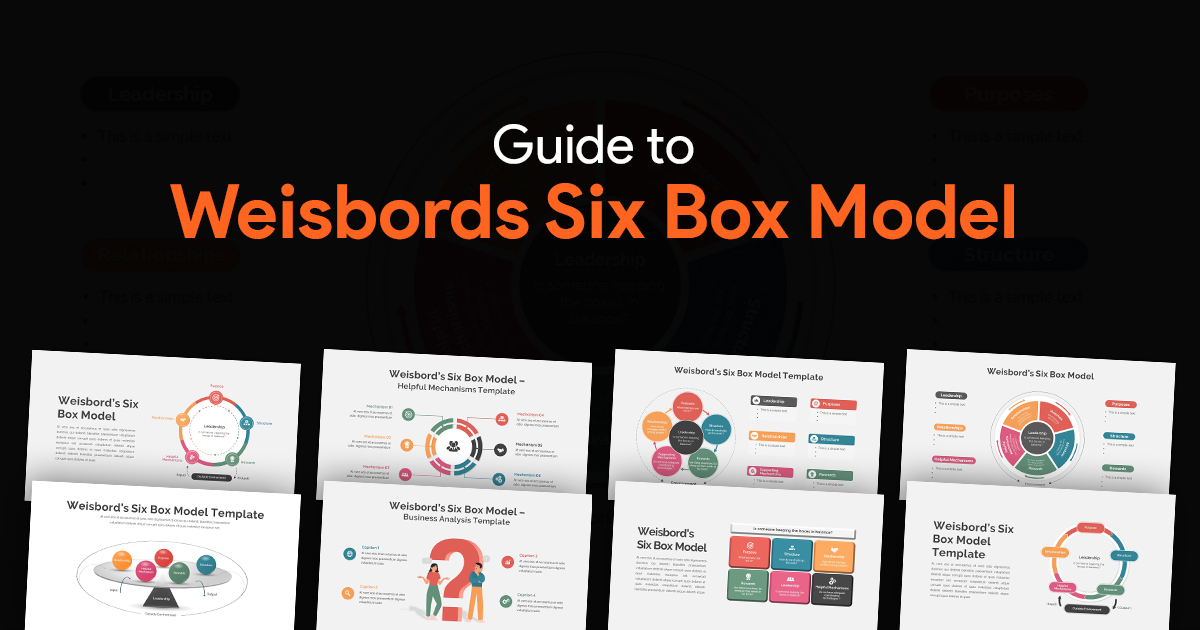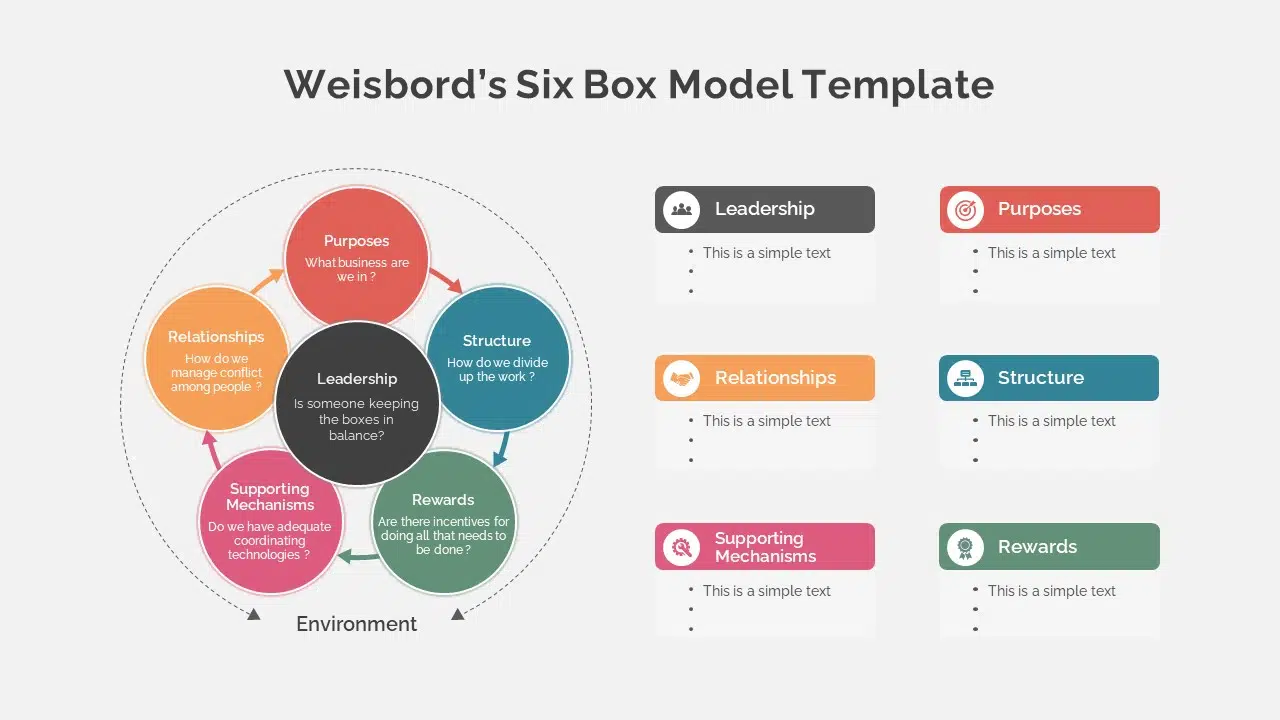Guide to Weisbord’s 6 Box Model

Weisbord six-box model is a professional management tool developed by American analyst Marvin Weisbord to evaluate the organization’s performance. It was designed to reveal organizational matters that get unnoticed by senior management and provides a structured way for management to expose problems without the task feeling too overwhelming.
Weisbord six-box model framework is a powerful tool to diagnose organizational issues with the support of six research areas of corporate development. It is mostly tied with assumptions and techniques that steer to improvements or performance using a clear-cut structure.
The structure of an organization may be either large or complex, so it is difficult to identify crucial problems or don’t know where to start the correction process regarding inefficiencies and weak performance. The Weisbord model supports managers in evaluating the organization’s performance in a controlled way by concentrating on problems such as scheduling, motivation and rewards, the role of support functions, inner competition between organizational divisions, partnerships, the chain of command, and the delegation of authority, corporate dividends and performance estimate. Weisbord six-box model diagnoses the issues of the organization by examining its inputs and outputs.
Why do organizations need performance diagnoses?
Organizations need a systematic tool to define and understand the underlying issues that obstruct the organization’s actual performance. The diagnoses include collecting and analyzing relevant data and drawing conclusions based on the findings to solve problems by implementing necessary changes. Being a collective approach, everyone in an organization should have participated in the diagnosis process and its implementation strategies. On the other hand, organizations that work in a controlled environment usually don’t have a very dynamic character, so they don’t need a lot of changes from a diagnostic viewpoint.

Weisbord’s Six-Box Model analysis
Weisbord’s six-box model uses six categories to diagnose an organization’s performance. First, according to Weisbord, identifying and solving a problem is something that should be done scientifically by the people themselves because they are the most aware of their situation. Second, a formal diagnosis is a way to bridge the gap between what is and what should be. Third, examining the six research areas enables organizations to uncover and draw conclusions to solve internal issues. Finally, an organizational diagnosis involves purposes, structures, relationships, leadership, rewards, and helpful mechanisms.
Purposes
Organizational purposes include the missions and viewpoints of an organizational vision. The employees must internalize these objectives and visions, and they need to accept them, even if their personal views about how things should be are entirely different. Here, managers or employees should understand what type of competition they face and how they see the business in the long term.
Structure
The structure of an organization determines the chain of command and its flows. Therefore, the system should give a clear idea of the legal power and provide an accurate and fitting overview of how the organization’s goals must be achieved and who is accountable. Besides, you should know business operations and their drawbacks in process development to keep business going. For example, a company should keep a formal setup even though mutual trust depends on informal relationships.
Relationships
Relationships include individuals, teams, technological, and other functional sections that effectively work together. Relationship management is crucial in keeping your trust at the utmost level. It also plays a key role in business performance.
Rewards
Reward systems include both formal and informal rewards and must be examined to ensure vital motivation among employees. For example, if your staff work overtime to compete with the nearest competitor, it is important to acknowledge their strenuous efforts and reward them for their hard work. This activity will boost their confidence and show more dedication to doing things in favor.
Leadership
Leadership mentions mainly to the managers within an organization, although non-managers can also have a leadership role within their squad. Company leaders need to use the human resources they have at their removal as effectively as possible. They also use resources and other equipment from the organization to try and realize the organization’s goals. They must improve the association between employees to work jointly towards their goal or on producing a single product. The effective leadership style they will employ is aimed at tasks and relationships, dealing with and monitoring objectives, identifying issues, and being highly adaptive to their internal and external setting.
Helpful mechanisms
Helpful mechanisms are systems that help workers to organize their activities. Examples of such mechanisms are depictions of administrative procedures, methods, meetings, notes, reports, perspectives, or combined information systems.
Pros of Weisbord’s Six-Box Model
- It is a diagnosis tool that provides a structure for evaluating your business.
- When your business is going to show fluctuations related to margins, you can use this evaluation tool.
- It is fit for both micro and macro-level evaluations
- Being a simple tool, anybody can use it easily
- It has already proved its relevance
Cons of Weisbord’s Six-Box Model
- The inward-looking evaluation process may ruin its viability since it lacks external influences in the analysis.
- Due to the macro nature, it takes time to finish the analysis.
Key takeaways of the Weisbord’s Six Box Model
- Weisbord’s six box framework is an evaluation tool that can assess how well a business performs and implements its strategy. American business analyst Martin R. Weisbord developed it.
- Weisbord’s six box model framework best identifies growth opportunities by avoiding cross-functional dilemmas between team members. Instead, it suggests the same key members must do the evaluation process on every occasion.
- Weisbord’s model combines six elements to diagnose your organization: purpose, structure, relationship, rewards, leadership, and helpful mechanism.
Final word
Weisbord identifies organizations can fulfill their goals through the sufficient application of inputs. Further, he says inputs are money, people, machinery, ideas, and other resources used to create an item. The outputs are products and services. So naturally, organizations don’t operate within a vacuum. But on the other hand, every organization functions in an environment that exposes it to countless influences. From the availability of raw materials to the availability of skilled workers, everything needs to be taken into account, but very little can be fully controlled. He further says competition is the most crucial external player for many organizations. This is why it’s significant that every businessperson analyses the competition scenario regarding customer needs to stay ahead of competitors.
You can use other popular business evaluation tools as an alternative to the Weisbord model framework. These tools are PESTLE analysis, VRIO framework, VMOST analysis, and Porter’s five forces.




